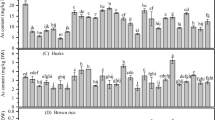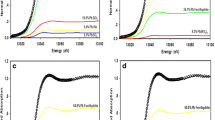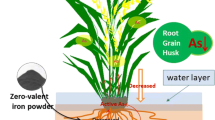Abstract
Background and aims
Limited information is available on comparing the iron plaque formation capabilities and their effect on arsenic (As) uptake by different rice plant genotypes grown in As-contaminated soils. This study investigates the effect of iron plaque on As uptake in different rice genotypes grown in As-contaminated soils from the Guandu Plain of northern Taiwan.
Methods
Twenty-eight rice genotypes including 14 japonica and 14 indica genotypes were used in this study. Rice seedlings were grown in As-contaminated soils for 38 days. The iron plaque formed on the rice roots were extracted using dithionite–citrate–bicarbonate. The concentrations of As, Fe, and P in soil solutions, iron plaque, and plants were measured. The speciation of As in the root’s iron plaque was determined by As K-edge X-ray absorption near-edge structure spectroscopy (XANES).
Results
The amounts of iron plaque formation on roots were significantly different among 28 tested rice genotypes, and 75.7–92.8 % of As uptake from soils could be sequestered in iron plaque. However, there were no significant negative correlations between the amounts of Fe or As in the iron plaque and the content of As accumulated in rice plants of tested genotypes. XANES data showed that arsenate was the predominant As species in iron plaque, and there were difference in the distribution of As species among different rice genotypes.
Conclusions
The iron plaque can sequester most of As uptake from soils no matter what rice genotypes used in this study. However, the iron plaque alone did not control the extent of As accumulation in rice plants from As-contaminated soils among 28 tested rice genotypes. Low As uptake genotypes of rice selected from this study can be recommended to be grown in the As-contaminated soils.





Similar content being viewed by others
References
Abedin MJ, Cresser MS, Meharg AA, Feldmann J, Cotter-Howells J (2002) Arsenic uptake and metabolism in rice (Oryza sativa L.). Environ Sci Technol 36:962–968
Ahmed ZU, Panaullah GM, Gauch H, McCouch SR, Tyagi W, Kabir MS, Duxbury JM (2011) Genotype and environment effects on rice (Oryza sativa L.) grain arsenic concentration in Bangladesh. Plant Soil 338:367–382
Arao T, Kawasaki A, Baba K, Matsumoto S (2011) Effects of arsenic compound amendment on arsenic speciation in rice grain. Environ Sci Technol 45:1291–1297
Bhattacharya P, Samal AC, Majumdar J, Santra SC (2010) Accumulation of arsenic and its distribution in rice plants (Oryza sativa L.) in Gangetic West Bengal, India. Paddy Water Environ 8:63–70
Bogdan K, Schenk MK (2009) Evaluation of soil characteristics potentially affecting arsenic concentration in paddy rice (Oryza sativa L.). Environ Pollut 157:2617–2621
Chen CC, Dixon JB, Turner FT (1980) Iron coatings on rice roots: morphology and models of development. Soil Sci Soc Am J 44:1113–1119
Chen Z, Zhu YG, Liu WJ, Meharg AA (2005) Direct evidence showing the effect of root surface iron plaque on arsenite and arsenate uptake into rice (Oryza sativa) roots. New Phytol 165:91–97
Chiang KY, Lin KC, Lin SC, Chang TK, Wang MK (2010) Arsenic and lead (beudantite) contamination of agricultural rice soils in the Guandu Plain of northern Taiwan. J Hazard Mater 181:1066–1071
Daus H, Weiss H, Mattusch J, Wennrich R (2006) Preservation of arsenic species in water samples using phosphoric acid—limitations and long-term stability. Talanta 69:430–434
Fitz WJ, Wenzel WW (2002) Arsenic transformations in the soil-rhizosphere-plant system: fundamentals and potential application to phytoremediation. J Biotechnol 99:259–278
Gee GW, Bauder JW (1986) Particle-size analysis. In: Klute A (ed) Methods of soil analysis, part 1, 2nd edn. Agron Monogr ASA and SSSA, Madi
Geng CN, Zhu YG, Liu WJ, Smith SE (2005) Arsenate uptake and translocation in seedlings of two genotypes of rice is affected by external phosphate concentrations. Aquat Bot 83:321–331
Hansel CM, Fendorf S (2001) Characterization of Fe plaque and associated metals on the roots of mine-waste impacted aquatic plants. Environ Sci Technol 35:3863–3868
Hansel CM, La Force MJ, Fendorf S, Sutton S (2002) Spatial and temporal association of As and Fe species on aquatic plant roots. Environ Sci Technol 36:1988–1994
Huang H, Zhu YG, Chen Z, Yin XX, Sun GX (2012) Arsenic mobilization and speciation during iron plaque decomposition in a paddy soil. J Soils Sediments 12:402–410
Hu Y, Li JH, Zhu YG, Huang YZ, Hu HQ, Christie P (2005) Sequestration of As by iron plaque on the roots of three rice (Oryza sativa L.) cultivars in a low-P soil with or without P fertilizer. Environ Geochem Health 27:169–176
Kalbitz K, Wennrich R (1998) Mobilization of heavy metals and arsenic in polluted wetland soils and its dependence on dissolved organic matter. Sci Total Environ 209:27–39
Lee CH, Hsieh YC, Lin TH, Lee DY (2013) Iron plaque formation and its effect on arsenic uptake by different genotypes of paddy rice. Plant Soil 363:231–241
Li RY, Stroud JL, Ma JF, McGrath SP, Zhao FJ (2009) Mitigation of arsenic accumulation in rice with water management and silicon fertilization. Environ Sci Technol 43:3778–3783
Liu WJ, Zhu YG, Hu Y, Williams PN, Gault AG, Meharg AA, Charnock JM, Smith FA (2006) Arsenic sequestration in iron plaque, its accumulation and speciation in mature rice plants (Oryza Sativa L.). Environ Sci Technol 40:5730–5736
Liu WJ, Zhu YG, Smith FA (2004) Smith SE Do iron plaque and genotypes affect arsenate uptake and translocation by rice seedlings (Oryza sativa L.) grown in solution culture? J Exp Bot 55:1707–1713
Mckeague JA, Day JH (1966) Dithionite and oxalate extractable Fe and Al as aids in differentiating various classes of soils. Can J Soil Sci 45:49–62
McLean EO (1982) Soil pH and lime requirement. In: Page AL et al (eds) Method of soil analysis, part 2, 2nd edn. Agron Monogr 9, ASA and SSSA, Madi
Meharg AA, Rahman M (2003) Arsenic contamination of Bangladesh paddy field soils: implications for rice contribution to arsenic consumption. Environ Sci Technol 37:229–234
Meharg AA, Williams PN, Adomako E, Lawgali YY, Deacon C, Villada A, Cambell RCJ, Sun G, Zhu YG, Feldmann J, Raab A, Zhao FJ, Islam R, Hossain S, Yanai J (2009) Geographical variation in total and inorganic arsenic content of polished (white) rice. Environ Sci Technol 43:1612–1617
Mehra OP, Jackson ML (1960) Iron oxide removed from soils and clays by a dithionite–citrate system buffered with sodium bicarbonate. Clays Clay Miner 7:317–327
Mei XQ, Ye ZH, Wong MH (2009) The relationship of root porosity and radial oxygen loss on arsenic tolerance and uptake in rice grains and straw. Environ Pollut 157:2550–2557
Mondal D, Polya DA (2008) Rice is a major exposure route for arsenic in Chakdaha block, Nadia district, West Bengal, India: a probabilistic risk assessment. Appl Geochem 23:2987–2998
Nelson DW, Sommers LE (1982) Total carbon, organic, and organic matter. In: Page AL et al (eds) Method of soil analysis, part 2, 2nd edn. Agron Monogr 9, ASA and SSSA, Madi
Norton GJ, Duan GL, Dasgupta T, Islam MR, Lei M, Zhu YG, Deacon CM, Moran AC, Islam S, Zhao FJ, Stroud JL, McGrath SP, Feldmann J, Price AH, Meharg AA (2009) Environmental and genetic control of arsenic accumulation and speciation in rice grain: comparing a range of common cultivars grown in contaminated sites across Bangladesh, China, and India. Environ Sci Technol 43:8381–8386
Panaullah GM, Alam T, Hossain MB, Loeppert RH, Lauren JG, Meisner CA, Ahmed ZU, Duxbury JM (2009) Arsenic toxicity to rice (Oryza sativa L.) in Bangladesh. Plant Soil 317:31–39
Raven KP, Jain A, Loeppert RH (1998) Arsenite and arsenate adsorption on ferrihydrite: kinetics, equilibrium, and adsorption envelopes. Environ Sci Technol 32:344–349
Schoof RA, Yost LJ, Eickhoff J, Crecelius EA, Crgin DW, Meacher DM, Menzel DB (1999) A market basket survey of inorganic arsenic in food. Food Chem Toxicol 37:839–846
Seyfferth AL, Webb SM, Andrews JC, Fendorf S (2010) Arsenic localization, speciation, and co-occurrence with iron on rice (Oryza sativa L.) roots having variable Fe coatings. Environ Sci Technol 44:8108–8113
Sheppard SC (1992) Summary of phytotoxic levels of soil arsenic. Water Air Soil Pollut 64:539–550
Smedley PL, Kinniburgh DG (2002) A review of the source, behavior and distribution of arsenic in natural waters. Appl Geochem 17:517–568
Su YH, McGrath SP, Zhao FJ (2010) Rice is more efficient in arsenite uptake and translocation than wheat and barley. Plant Soil 328:27–34
Syu CH, Jiang PY, Huang HH, Chen WT, Lin TH, Lee DY (2013) Arsenic sequestration in iron plaque and its effect on As uptake by rice plants grown in paddy soils with high contents of As, iron oxides, and organic matter. Soil Sci Plant Nutr 59:463–471
Takahashi Y, Minamikawa R, Hattori KH, Kurishima K, Kihou N, Yuita K (2004) Arsenic behavior in paddy fields during the cycle of flooded and non-flooded periods. Environ Sci Technol 38:1038–1044
Wang S, Mulligan CN (2006) Effect of natural organic matter on arsenic release from soils and sediments into groundwater. Environ Geochem Hlth 28:197–214
Williams PN, Raab A, Feldmann J, Meharg AA (2007a) Market basket survey shows elevated levels of as in South Central US processed rice compared to California: consequences for human dietary exposure. Environ Sci Technol 41:2178–2183
Williams PN, Villada A, Deacon C, Raab A, Figuerola J, Green AJ, Feldmann J, Meharg AA (2007b) Greatly enhanced arsenic shoot assimilation in rice leads to elevated grain levels compared to wheat and barley. Environ Sci Technol 41:6854–6859
Wu C, Ye ZH, Shu WS, Zhu YG, Wong MH (2011) Arsenic accumulation and speciation in rice are affected by root aeration and variation of genotypes. J Exp Bot 62:2889–2898
Wu C, Ye ZH, Wu SC, Deng D, Zhu YG, Wang MH (2012) Do radial oxygen loss and external aeration affect iron plaque formation and arsenic accumulation and speciation in rice? J Exp Bot 63(8):2961–2970
Xu XY, McGrath SP, Meharg AA, Zhao FJ (2008) Growing rice aerobically markedly decreases As accumulation. Environ Sci Technol 42:5574–5579
Zhao FJ, McGrath SP, Meharg AA (2010) Arsenic as a food chain contaminant: mechanism of plant uptake and metabolism and mitigation strategies. Annu Rev Plant Biol 61:535–559
Acknowledgments
The financial support from the National Science Council, Executive Yuan, Taiwan (grant no. NSC-101-2313-B-002-012-MY3) is sincerely appreciated. The XANES studies reported here were performed at the NSRRC, Taiwan, under project no. 2012-2-045-1. The authors thank the staff at NSRRC for their assistance during the experiments.
Author information
Authors and Affiliations
Corresponding author
Additional information
Responsible Editor: Fangjie Zhao.
Rights and permissions
About this article
Cite this article
Syu, CH., Lee, CH., Jiang, PY. et al. Comparison of As sequestration in iron plaque and uptake by different genotypes of rice plants grown in As-contaminated paddy soils. Plant Soil 374, 411–422 (2014). https://doi.org/10.1007/s11104-013-1893-8
Received:
Accepted:
Published:
Issue Date:
DOI: https://doi.org/10.1007/s11104-013-1893-8




